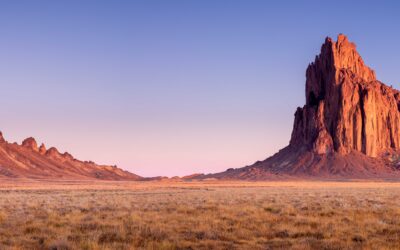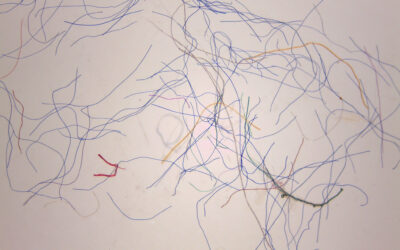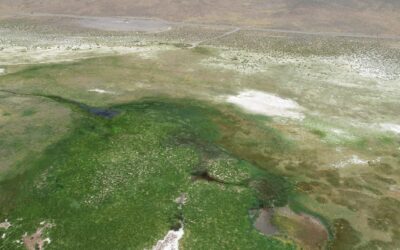LAKE TAHOE (JUNE 29, 2021) –– With a paddle in one hand and a smartphone in the other, Emily Frey leaned over the hull of her kayak to snap a photo of an aquatic plant fragment floating on Tahoe’s deep blue waters. The photo is part of a report she submitted through the recently updated Citizen Science Tahoe app – a free, mobile-ready tool to crowdsource the collection of important scientific data Tahoe’s environment. In the midst of Tahoe’s busy summer season, and with the Fourth of July weekend approaching, the app update is well-timed to engage thousands of visitors in protecting Tahoe’s environment by quickly and easily reporting observations of aquatic invasive species, litter, water quality, algae, and more.
“With the Citizen Science Tahoe app, anyone can help Keep Tahoe Blue by taking a few minutes to report what you see at the lake,” said Frey, Citizen Science Program Coordinator for the League to Save Lake Tahoe. “While you’re paddling, hiking, or just lounging, pop open the app and report cloudy water, algae, invasive species, or litter on the beach. Tahoe scientists can’t have their eyes on the Lake at all times, but together we can.”
The app was developed by the UC Davis Tahoe Environmental Research Center (TERC) in 2015 to collect citizen science data as ground-truthing for Lake Tahoe’s real-time nearshore monitoring network. The League to Save Lake Tahoe (Keep Tahoe Blue) and Desert Research Institute (DRI) joined shortly after, adding a range of new surveys offered through the app. This summer, the team welcomed three additional partners: Clean Up the Lake, the Tahoe Water Suppliers Association, and Take Care Tahoe.
“The Citizen Science Tahoe app is growing, which is great news for Lake Tahoe and everyone who enjoys it,” said Heather Segale, Education and Outreach Director with the UC Davis Tahoe Environmental Research Center. “When ‘citizen scientist’ volunteers – visitors, locals, and everyone in between – submit data through the app, it advances our understanding of Lake Tahoe and informs research and advocacy efforts to better preserve this special place.”
With the addition of new partners, the app is even more useful. As Clean Up the Lake continues to protect Tahoe’s environment, the organization is using the app to record litter found on the shoreline that may end up in the Lake if not picked up or reported. Take Care Tahoe community ambassadors are reporting issues they see in Tahoe’s environment, along with the interactions they have when helping visitors explore Tahoe’s outdoors responsibly. Visitors can use the app to find or report water refill stations thanks to the Tahoe Water Suppliers Association.
“Citizen science is accelerating our understanding of how and when Tahoe gets its water, whether as rain, snow or a wintry mix,” said Meghan Collins, Education Program Manager at the Desert Research Institute in Reno. “Millions of people depend on Tahoe for their water supply. The Citizen Science Tahoe app allows Tahoe-lovers to advance science and practice environmental stewardship all year long.”
The Citizen Science Tahoe app’s recent updates have made it more flexible for scientists, and quicker and easier for users. Visit citizensciencetahoe.org to get started. The upgraded app doesn’t need to be downloaded, and you don’t even need to use your cellular data. Simply wait to upload images once you’re connected to Wi-Fi. This makes the app easy to use in even the most remote locations.
###
Media Resources: photos
Media Contacts:
Heather Segale, UC Davis Tahoe Environmental Research Center; hmsegale@ucdavis.edu, 530-906-9100 The UC Davis Tahoe Environmental Research Center (TERC) is dedicated to interdisciplinary research and education to advance the knowledge of aquatic and terrestrial ecosystems and to communicate science-informed solutions worldwide. Interested in learning about Lake Tahoe? When you visit the Tahoe Science Center, you learn the latest findings from the world-class UC Davis Tahoe Environmental Research Center, a global leader in research, education, and public outreach on lakes. Advanced reservations are required at tahoe.ucdavis.edu/tahoesciencecenter.
Kelsey Fitzgerald, Desert Research Institute; kelsey.fitzgerald@dri.edu, 775-741-0496 The Desert Research Institute (DRI) is a recognized world leader in basic and applied environmental research. Committed to scientific excellence and integrity, DRI faculty, students, and staff have developed scientific knowledge and innovative technologies in research projects around the globe. Since 1959, DRI’s research has advanced scientific knowledge, supported Nevada’s diversifying economy, provided science-based educational opportunities, and informed policy makers, business leaders, and community members. With campuses in Reno and Las Vegas, DRI serves as the non-profit research arm of the Nevada System of Higher Education. For more information, please visit www.dri.edu.
Chris Joseph, League to Save Lake Tahoe/Keep Tahoe Blue; cjoseph@keeptahoeblue.org, 805-722-5646 The League to Save Lake Tahoe, also known by its iconic slogan “Keep Tahoe Blue,” is Tahoe’s oldest and largest nonprofit environmental advocacy organization. Our team of solutions-oriented Tahoe advocates use innovation, boots-on-the-ground action, and a holistic approach to solve the environmental challenges threatening the lake we love. In our 64th year, we continue pushing to Keep Tahoe Blue in an ever-changing world. Learn more at keeptahoeblue.org.


